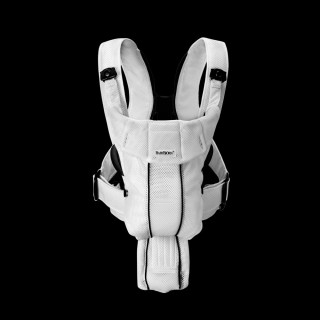- Manufacturer: Babybjörn
- Designer: Ergonomidesign
- Material: polyester
- www.babybjorn.com

Index
- Manufacturer BabyBjörn AB is a family-owned, Swedish company founded in 1961. BabyBjörn's goal has been to simplify everyday activities for parents and small child
- History A cradle board is a Native American baby carrier used to keep babies secure and comfortable and at the same time allowing the mothers freedom to work
- Mobility Each area of the world has a traditional baby carrier designed to meet their particular needs, i.e. hot/cold climate, type of work mothers do, cultura
- Export Entering a period of rapid development beginning 2000, China became the world's leading supplier of baby carriages and related parts in 2006, with ove
- Manufacture Slings and cloth carriers are manufactured from fabrics and polyester fiber or foam for stuffing or padding. Velcro fasteners, woven fabric webbing fo
- Designer Ergonomidesign is Sweden's oldest established full service design studio. Founded in 1969 when Design Gruppen merged with Ergonomidesign, they have a
- Security These combinations of characteristics have not been easy for manufacturers to produce successfully. Consumer protection groups like the Consumer Produ
BabyBjörn AB is a family-owned, Swedish company founded in 1961. BabyBjörn's goal has been to simplify everyday activities for parents and small children by developing innovative products for children up to the age of three.
Materials
Baby Carrier Synergy is designed to carry babies from 3,5 kilos up to 12 kilos. The airy, breathable material keeps both baby and wearer cool whilst providing maximum carrying comfort. The mesh fabric, exclusively developed for BabyBjörn, shapes itself to the baby's body and provides excellent support for the baby's back and head.
A cradle board is a Native American baby carrier used to keep babies secure and comfortable and at the same time allowing the mothers freedom to work and travel.
The cradleboards were attached to the mother's back straps from the shoulder or the head.
Each area of the world has a traditional baby carrier designed to meet their particular needs, i.e. hot/cold climate, type of work mothers do, cultural/traditional wearing positions.
- For instance Mexican people use the Rebozo, which is a square of woven cloth tied over one shoulder with baby usually on the back.
- Peruvians have a Manta which sits over both shoulders like a cape, and baby sits high on mother's back.
- Guatemalans use Parraje - similar to a Rebozo.
- Alaskan/Canadian people have the Amauti which is a very thick arctic jacket with a baby 'pocket' in the back, baby even fits under the over-sized hood.
- Papua New Guinea mothers use a Bilum- a net bag held at the forehead with baby hanging at the back.
- Indonesian mothers use a Selendang which is a long ornate wrap.
- Aboriginal mothers used to keep their babies in carriers made of bark, similar to the cradleboards used by Native Americans but without the cloth covering.
- Asian mothers use a variety of carriers including Mei-tai /Hmong/ Bei (China)
- Welsh mothers used to wear their babies in warm shawls, called 'Siol Fagu'.
- Ethiopian mothers use a blanket with top straps, similar to the Onbuhimo.
- African mothers use a 'Khanga' which is a short-ish piece of cloth tied around the torso, so baby sits low on the back.
- Maori women carried their babies in a cloth inside their cloaks, or in a flax Pikau (backpack).
Evolution
Although the carrying of children on the body using devices is a relatively recent phenomen in the West, the practice has been established in many cultures for centuries.
Images of children being carried in slings can be seen in Egyptian artwork dating back to the time of the Pharaons, and have been used in many indigenous cultures. On-the-body baby carrying in the west started being known in the 1960s with the advent of the structured soft pack in the mid 1960s. In the early 1970s, in Germany, the wrap was reintroduced. In 1986, the ring sling was invented and popularized. In the early 1990s, the modern pouch carrier was created in Hawaii.
While the Chinese mei tai has been around in one form or another for centuries, it did not become popular in the west until it was modernized with padding and other adjustments. It first became popular and well known in mid-2003.
Entering a period of rapid development beginning 2000, China became the world's leading supplier of baby carriages and related parts in 2006, with overseas shipments worth more than $660 million. Exports remained strong in 2007, increasing 17 percent to $778 million. Demand from North America and the EU are expected to be the primary drivers of growth. Together, these two regions currently account for 62 and 55 percent of China's revenue from shipments of baby carriages and vehicle seats, respectively.
China is among the world's largest suppliers of baby strollers, car seats and carriers. Suppliers offer a wide range of products with the majority of designs positioned as low-end or midrange. But the number of high-end models is increasing as more suppliers move up the value chain to gain better margins.
Upcoming models will be fitted with more functions and accessories, especially those promoting safety and convenience.
Exports are expected to grow stronger in coming months. The EU and North America will remain key markets, but other regions, including such as Asia, the Middle East and South and Central America, are expected to gain importance.
Slings and cloth carriers are manufactured from fabrics and polyester fiber or foam for stuffing or padding. Velcro fasteners, woven fabric webbing for straps, and metal buckles and fasteners for supports around the parent are used to hold cloth carriers in place. Backpack-type carriers can be made mostly of cloth, but a second type consists of an aluminum frame with a cloth support for the baby and padded cloth straps that adjust to the parent.
The rigid or molded infant carrier is made of polypropylene, a medium-impact plastic. Metal components are made of steel by specialized metal fabricators. Rivets and fabric fasteners may be made of other metals but are also supplied by specialty contractors.
Fabrics used to make infant cariers include durable fabric like denim and nylon mesh and webbing for hamesses.
Ergonomidesign is Sweden's oldest established full service design studio. Founded in 1969 when Design Gruppen merged with Ergonomidesign, they have a long history of releasing award-winning human-centered design solutions based on a strong philosophy of user-centered innovation espoused by the founders.
Housed in Bromma, a suburb of Stockholm, their space is as inspiring as it must have been designed.
Ergonomidesign has a unique corporate structure, one that Krister Torssell, their Managing Director, believes enhances the firm's ability to better serve their clients and nimbly execute projects.
These combinations of characteristics have not been easy for manufacturers to produce successfully. Consumer protection groups like the Consumer Product Safety Commission list a number of carriers that have been recalled. The molded plastic carriers have had notable problems such as failure of the handle locks that can cause the carrier to release and tip the baby out. But the cloth carriers have also been made with leg openings that are too large and allow tiny babies to slip through. To the manufacturers' defense, many more problems have been cited related to misuse of the carriers by the adults caring for the infants. Sitting a rigid carrier on a soft surface like a couch permits the baby's movements to tip the carrier over. In 1997 alone, over 8,700 children were brought to the emergency room and treated for falls from carriers. Also, a number of medical reports show that infants are left in one position in the carriers for too long. In the supine or reclining position, the back of the baby's head flattens as it rests against the carrier.































































































